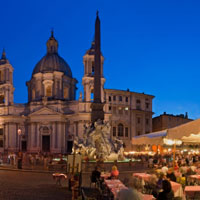
By Dianne Hales
www.becomingitalian.com
As day softens into dusk in Italy, something in the air seems to tug people from their homes and workplaces to participate in one of the enduring traditions of Italian life: la passeggiata. This evening promenade, generally between 5 and 8 PM, occurs in virtually every town, village, or big city in Italy. Here are my tips for joining in the tradition, and some favorite spots for strolling in Italian cities.
Andiamo a fare qualche vasca! (Literally, let’s go do some laps—as in a pool), Italians say to one another. However, this “cultural performance,” as sociologists describe it, involves much more than strolling to and fro.
The Most Italian Time of Day
During the week, the passeggiata marks the end of the workday and offers a moment of sociability before the family dinner. On Saturday and Sunday, the passeggiata often becomes the main social event of the day, when entire families take to the streets.
The most important thing, it seems, is simply seeing and being seen (vedere e farsi vedere). In some cities, people clearly dress to impress or at least to show how well life has been treating them. Shirts are pressed; jeans, if worn, are stylish. Even babies in their prams are ready for proud display.
Attracting the most attention are young women of marriageable age, who, as Giovanna Delnegro observes in her book The Passeggiata, take advantage of “a socially sanctioned opportunity for flirting and courting.” Parents encourage such behavior, she notes, because “the rhetorical skills learned in the piazza become useful in the marriage market, the work place and the complex politics of the town.”
Recommended Fodor’s Video
For townspeople of all ages, the passeggiata reinforces a sense of belonging. The greeting of friends and acquaintances, the swapping of gossip, and the sharing of the latest news weave everyone into the human fabric of the community.
Join the Passeggiata
If you’re out and about in the early evening, you may become part of a passeggiata whether you intend to or not. You’ll feel like less of an outsider if you dress up a little. Walk slowly. Stop for a gelato or an aperitivo. And don’t be surprised if, after a while, you start feeling that you too belong.
In most villages, it’s easy to find la passeggiata. Just head for the corso or main street or the liveliest piazza. Here are three of my favorite cities to fare una passeggiata:
Rome
Young travelers tend to mull about the Piazza di Spagna or find a perch on the Spanish Steps to watch the parade. Window-shoppers gravitate to the Via del Corso, a pedestrian street lined with shops, cafes, and churches. The lively Piazza Navona, with its open-art art vendors, mimes, and musicians, may be the most entertaining place for your passeggiata.
The Borghese Gardens, where families pause to let their children ride the carousel or chase pigeons, offers a more tranquil setting. One of the best places to end a Roman passeggiata is the Pincio, poised above the Piazza del Popolo with a wonderful view over the cupolas of Rome’s churches (including St. Peter’s) to the often-spectacular sunset.
Florence
Florence’s narrow streets provide welcome shade in the late afternoon. Many people weave their way to the Piazza della Repubblica, with its choice of cafes and bars for an espresso or aperitivo. I prefer a different route: a hike (or bus ride) to the Piazzale Michelangelo or, continuing upward, to the church of San Miniato, where locals sit in the shade and couples wrap their arms around each other as they watch the sun turn the Arno to gold.
Siena
The buses that bring many visitors to this medieval city leave by late afternoon. That’s when the Sienese reclaim their town by making their way up the steep, winding streets to Il Campo, the shell-shaped main piazza. You can circumnavigate the piazza, as many do, or venture into the tiny side streets and alleys.
For a bird’s eye view, climb the 400 steps to the top of the Torre del Mangia (roughly translated, the Tower of the Eater, from its first guardian, nicknamed Mangiaguadagni for his tendency to spend all his money for food). As you gaze down at groups of townspeople walking and talking below, you’ll feel—as Italians do at the end of a passeggiata—that all’s right with the world.
About the Author
Dianne Hales spent considerable time in Rome studying Italian and doing research for her book, La Bella Lingua: My Love Affair with Italian, the World’s Most Enchanting Language, which is now available in paperback. You can find out more at becomingitalian.com.
Photo credits: Piazza Navona: istock / fotoVoyager



